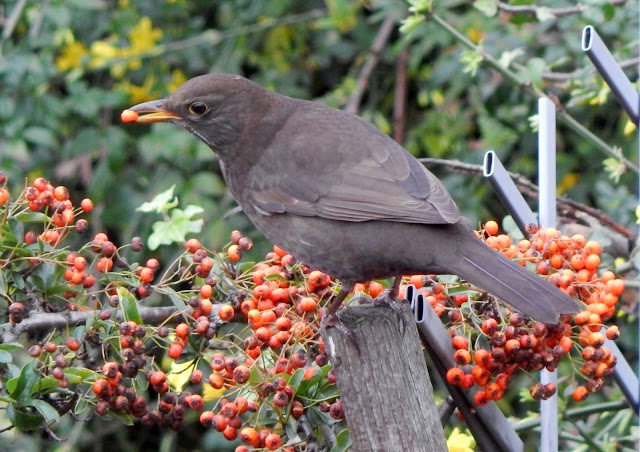 |
| Sprays of cream coloured tiny flowers are followed by berries in the Autumn. |
 |
| I have Pyracantha growing in my own small city-centre garden, and love to watch the birds feasting on the berries.. |
 |
| This art piece was inspired by the spirit and shape of the Pyracantha section. |
 |
| This small Pyracantha branch is on its way to being a wand. I believe pyracantha to be both magical and powerful., highly suited to wand making...I have removed all the side shoots and thorns, and stripped some of the bark. I will leave a small portion to retain the character and integrity of the piece. |
 |
| The wand has been sanded smooth, leving visible the dark spots which were the thorn growth points. I see these as miniature power points, spread along the length of the wand. |
 |
| I have added runes. |
 |
| This piece is strong, characterful, and tactile ... |
 |
My finished
Pyracantha Wand |
 |
| Pyracantha Pendant |
 |
| Pyracantha Brooch |
 |
| Two Art Pieces created using Pyracantha. You can see more on my 'Pyro-Art' page. |
 |
| The thorns are extremely sharp! |
Three years ago when I started out with my new pyrography machine, I knew absolutely nothing about pyrography..or wood, so I just set to experimenting with whatever pieces came my way..and learned through experience. One of the first oddments of wood a came acroos was a small slice of Pyracantha , also known as 'Firethorn'. It is a very common garden shrub, also planted around municipal buildings..almost ubiquitous; useful in the garden as it bears colourful berries for winter colour and also good for attracting birds..still easily passed by without a second glance. If you have a pyracantha in need of pruning you are unlikely to come away unscathed! The thorns are exceedingly sharp, and protrude at all angles..sometimes tucked away in the nodes of branches..and very strong. As it turned out, the slice I had aquired was unusually large by normal standards - it was a slice of the 'trunk' of an old specimen, about 5.5 cm in diameter, whereas these shrubs mostly spread out with a lot of twiggy growth but not much trunk. I was pleased with the result of this early design, and then went on to experiment with other woods, gradually gaining an understanding of the qualities I needed from the wood as I began to develop my own style. It became increasingly clear that, as with my traditional drawing and painting, I desired to create detailed designs on a small scale..and this required special qualities in the wood. Fruitwoods proved to be good, also Hazel and Birch, and yet three years on Pyracantha remains, for many reasons, my favourite wood. I love it's character and growth style - it is quite knobbly, with beautiful bark, and has to be tamed..due to those thorns! It isn't easy to find larger pieces, but working on such a small scale means I'm fortunate to use garden clippings which most people would discard. In fact, I have not come across anyone else using Pyracantha in pyrography! This is most likely because the majority of Pyrographers work on a much larger scale, so for them pyracantha simply would not be an option. Perhaps you could leave a comment if you or someone you know does so...
 |
| Pyracantha bark is grey in colour , with distinctive markings. Small nodules cover the surface in some varieties. Very characterful and eccentric is how I would describe this wood! Perhaps that is why I adore it so! |
 |
| Pyracantha can be sanded to produce a beautfully smooth surface |
 |
| It is quite unusual to find pieces as thick as this |
















I have a huge Pyrocantha tree some 15feeet plus tall. It must go.
ReplyDeleteIf anybody would like it, please come and take it (All of it must go) North London. Transplant it or use the wood.
I do not want to waste it and I do not want money for it. A donation to charity would be nice.
justiceforgerry@yahoo.com